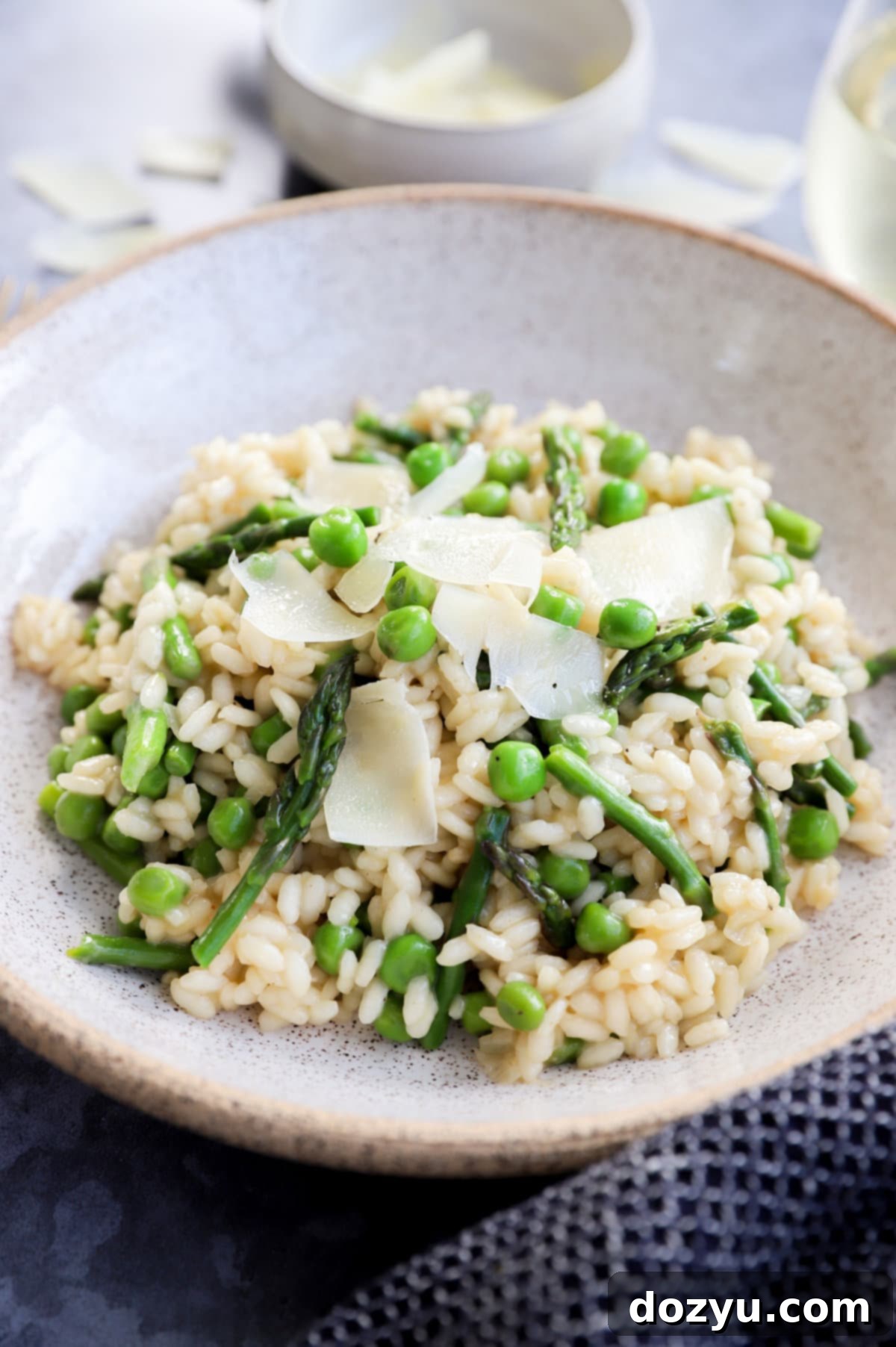Creamy Spring Risotto with Asparagus and Peas: An Easy & Flavorful Recipe
Welcome the freshness of spring into your kitchen with this incredibly simple yet profoundly flavorful Risotto with Asparagus and Peas. This dish transforms tender Arborio rice into a luscious, creamy base, perfectly complemented by the vibrant crunch of fresh asparagus and the sweet pop of plump peas. It’s a versatile recipe that effortlessly elevates any springtime meal, whether you’re serving it as a light side dish, a comforting starter, or a hearty vegetarian main course. Prepare to impress your taste buds with minimal effort and maximum deliciousness!
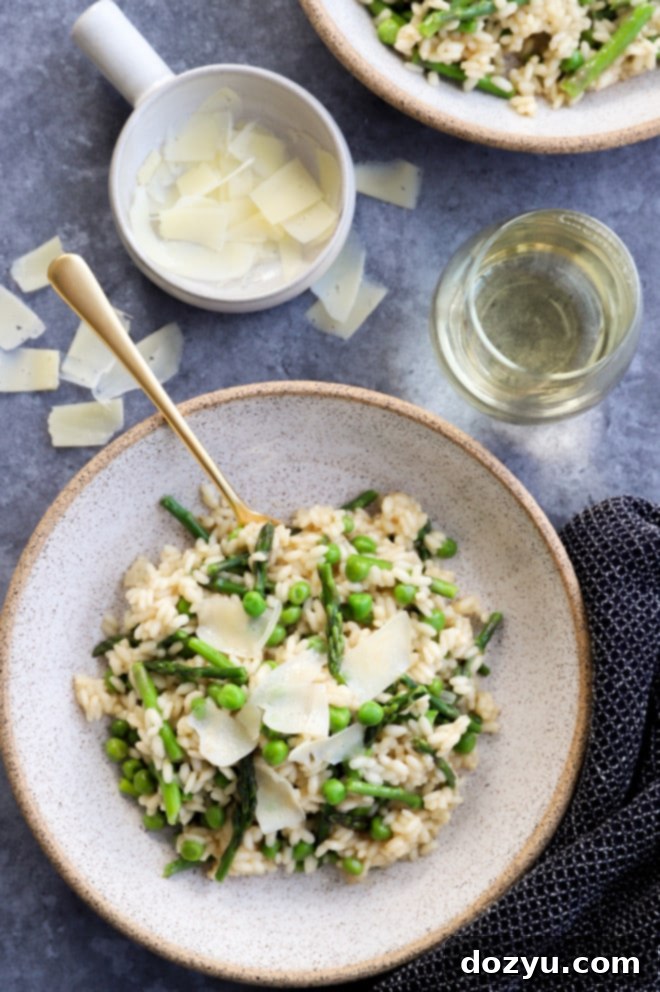
Table of Contents
Toggle
About This Delightful Spring Risotto
For years, I’ve had a delightful tradition of creating a unique risotto for each season – a rich, earthy one for fall, a comforting version for winter, and a sunny one for summer. However, the vibrant season of spring always seemed to slip through the cracks! Perhaps it was the sheer abundance of fresh spring produce that left me overwhelmed with choice, or simply the busy currents of life. But finally, just in time for the arrival of spring, I’ve perfected a light, bright, and utterly delicious risotto that captures the essence of this rejuvenating season.
Risotto is more than just a meal; it’s a culinary ritual. It’s a dish that demands your presence, encouraging you to slow down and savor the process of cooking. The constant stirring required to achieve that signature creamy texture means staying close to the stove, allowing you to fully immerse yourself in the aroma and transformation of simple ingredients into something truly special. This mindful approach to cooking makes it a wonderful way to unwind and enjoy the art of creation in your kitchen.
It’s also become a cherished activity to share with our little one, “Babycakes,” who, at this stage, excels at stirring! There’s a joy in introducing new generations to the simple pleasures of home cooking.
This spring risotto, starring crisp asparagus and sweet peas, serves as an incredible foundation for countless meals. Its adaptable nature means you can easily customize it to your liking. Feel free to incorporate other seasonal vegetables like tender zucchini or earthy mushrooms, or swap them entirely based on what’s fresh and available. A sprinkle of fresh herbs from your garden can elevate the flavors even further. Once you experience the magic of this recipe, it’s sure to become a regular fixture in your spring cooking rotation!
Is Risotto Difficult to Make? A Beginner’s Guide
The common misconception about risotto is that it’s incredibly difficult or reserved for experienced chefs. The truth is, making risotto isn’t hard at all! What it truly demands is patience and a little focused attention. This is not a dish to rush. While the entire cooking process typically takes less than an hour, attempting to speed it up by cranking up the heat or skipping essential steps will compromise the silky, creamy texture that makes risotto so irresistible.
If you’re new to the world of risotto, I highly recommend exploring a comprehensive guide on how to make risotto. There, you’ll find all the foundational techniques and tips to ensure a perfect outcome every time. Once you understand the basic principles – like gradually adding warm stock and stirring frequently – you’ll quickly master the method. Soon, you’ll be confidently creating a variety of seasonal risottos throughout the year, each one a testament to your newfound cooking prowess!
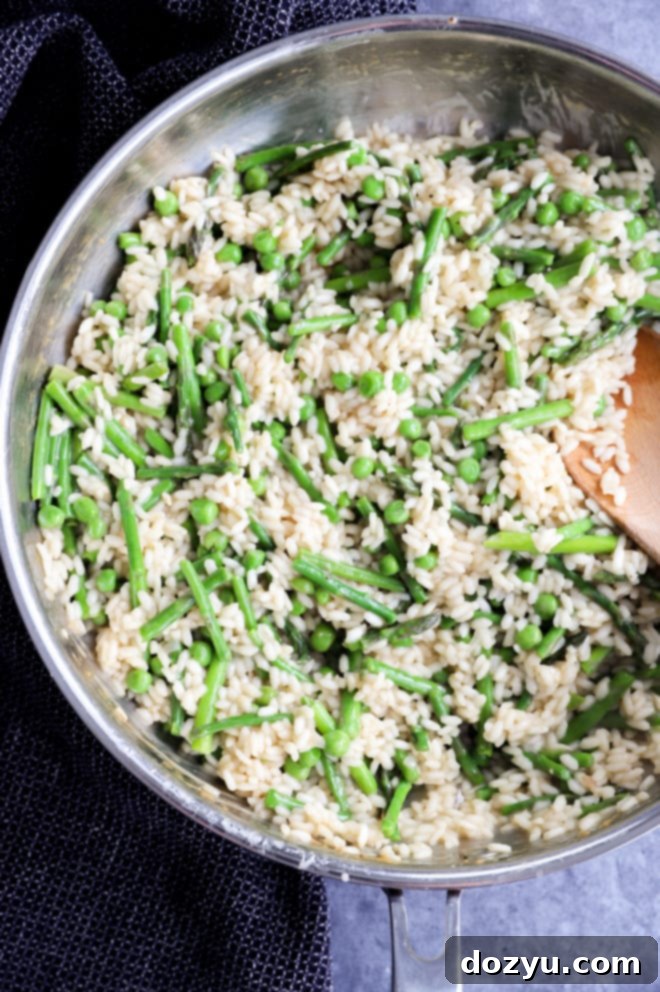
Essential Ingredients for Asparagus and Pea Risotto
Crafting a truly memorable risotto starts with selecting high-quality ingredients. Here’s a closer look at what you’ll need for this vibrant spring dish:
- Stock: The foundation of any great risotto! I prefer using rich chicken stock for its depth of flavor. However, for a delightful vegetarian version, opt for a good quality vegetable stock. Both chicken broth and vegetable broth can also be used interchangeably.
- Olive Oil: A staple in Italian cooking, extra-virgin olive oil provides a subtle fruity note and helps sauté our vegetables beautifully.
- Asparagus: The star of the show! Always choose fresh asparagus for the best flavor and texture. Remember to snap or trim off the tough, woody ends before cutting the spears into appealing 1-inch pieces.
- Peas: Frozen peas are a fantastic convenience and retain their sweetness well. If you’re lucky enough to find fresh peas, they’ll elevate the dish even further. Simply add fresh peas at the very end of the cooking process to ensure they remain tender and bright green.
- Butter: Unsalted butter allows you complete control over the seasoning of your risotto. If you only have salted butter, simply adjust the amount of added salt throughout the cooking process. Butter is essential for that luxurious, creamy finish.
- Aromatics: A dynamic duo of shallots and garlic provides the aromatic backbone for this risotto. Shallots offer a milder, sweeter onion flavor, while fresh minced garlic adds a pungent warmth that truly elevates the overall taste profile.
- Rice: For authentic risotto, Arborio rice is non-negotiable. This short-grain rice variety is specially chosen for its high starch content, which releases beautifully when stirred, creating the signature creamy texture. While other rice types exist, this recipe is specifically designed for Arborio, and using long-grain rice would require different liquid ratios and yield a less creamy result.
- White Wine: A dry white wine, such as a Sauvignon Blanc, Pinot Grigio, or a non-oaky Chardonnay, adds a crucial layer of acidity and complexity, deglazing the pan and infusing the rice with wonderful flavor. The alcohol cooks off during the simmering process, leaving only the exquisite taste.
- Parmesan Cheese: Freshly grated Parmesan cheese is absolutely essential for the best flavor and melt-in-your-mouth texture. Skip the pre-grated options, which often contain anti-caking agents, and grate your own from a block. Don’t toss those Parmesan rinds – they’re perfect for adding incredible depth to soups and stocks!
Kitchen Essentials for Perfect Risotto
While risotto is a simple dish in principle, having the right tools can make the process even more enjoyable and ensure a perfect outcome. Here are the must-haves for this asparagus and pea risotto:
- Chef’s Knife and Cutting Board: Essential for efficiently trimming and preparing your fresh asparagus and finely chopping the shallots and garlic.
- Risotto Skillet or Large Sauté Pan: A wide, deep skillet with tall sides is ideal for risotto. It provides ample surface area for the rice to cook evenly and for all that delicious liquid to evaporate gradually, while the high sides prevent splattering as you stir. My favorite risotto skillet is perfectly sized, even allowing you to easily double this recipe!
- Wooden Spoon: You’ll be doing a fair amount of stirring, and a sturdy wooden spoon is gentle on your cookware and comfortable in your hand.
- Small Saucepan: Crucial for keeping your chicken or vegetable stock warm. This seemingly small step is a game-changer for achieving that ultimate creamy risotto texture.
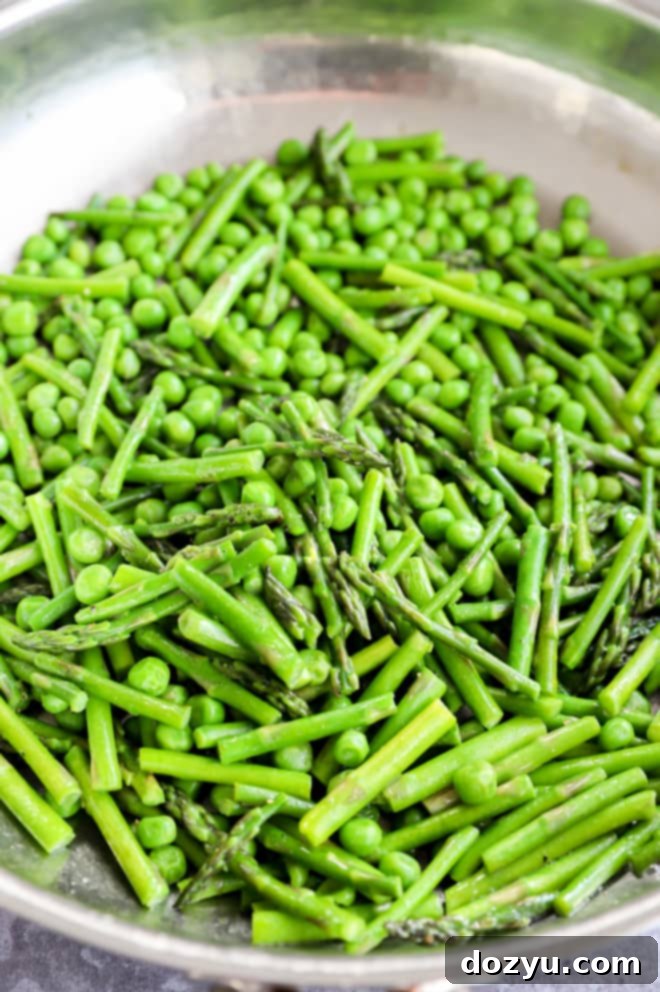
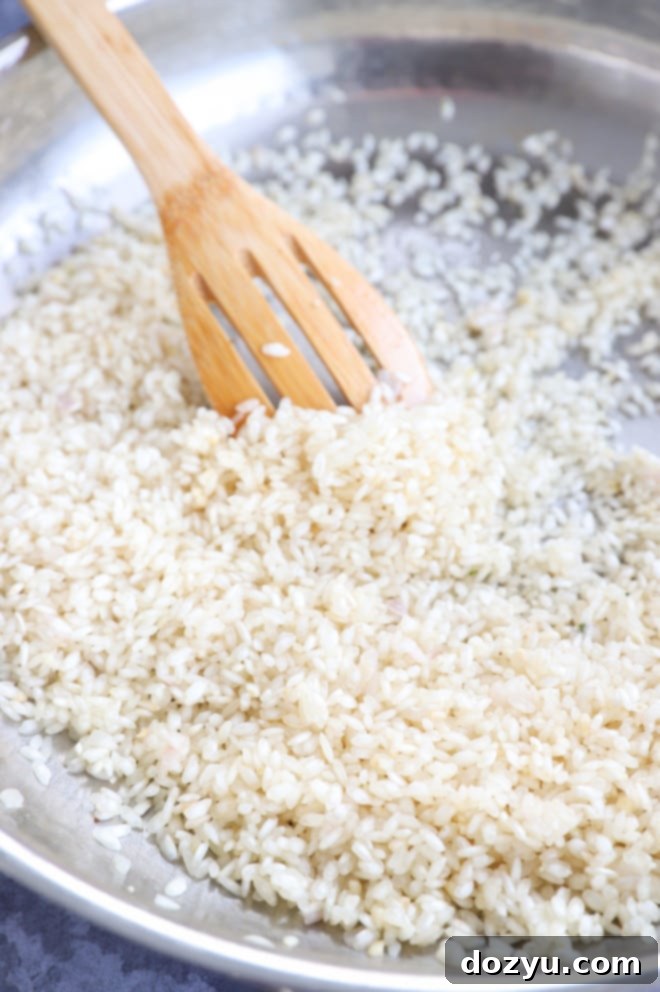
Step-by-Step: Crafting Your Asparagus and Pea Risotto
Prepare the Fresh Spring Vegetables
Begin by setting up your warm stock. In a small saucepan, bring your chicken or vegetable stock to a gentle simmer, then cover it and keep it warm over low heat. This constant warmth is key for a truly creamy risotto. Next, in your large skillet, heat the olive oil over medium-low heat. Once shimmering, add your trimmed 1-inch asparagus pieces, seasoning them with a pinch of salt and pepper. Sauté for 2 to 4 minutes, stirring occasionally, until they are tender-crisp – the cooking time will vary slightly depending on the thickness of your asparagus spears. Stir in the frozen peas and cook for just another minute until they are thawed and bright green. Transfer these vibrant vegetables to a plate or bowl and set them aside; they’ll be added back in at the end to maintain their perfect texture.
Toast the Arborio Rice
Using the same skillet (no need to clean it!), melt two tablespoons of unsalted butter over medium heat. Add the finely chopped shallots and cook until they are soft and translucent, usually about 2 to 3 minutes. Stir in the minced garlic and cook for one more minute until it becomes wonderfully fragrant. Now, add the Arborio rice to the pan. Toast the rice, stirring it occasionally for about 2 minutes. This “toasting” step helps to seal the outer surface of the rice grains, allowing them to absorb the liquid more evenly and maintain a slight bite in the center, which is characteristic of perfectly cooked risotto.
The Risotto Cooking Process: Stir & Absorb
Pour in the white wine and let it simmer, stirring constantly, until it has almost completely evaporated. This deglazes the pan and infuses the rice with a fantastic layer of flavor. Next, add approximately 1 cup of your warm stock to the rice. Cook, stirring continuously, until the liquid has been fully absorbed by the rice. This constant stirring is vital as it helps release the starches from the Arborio rice, creating that luxurious, creamy sauce. Continue this process, adding one cup of warm stock at a time and stirring patiently until each addition is absorbed. Keep tasting the rice between additions – you’re looking for an al dente texture, tender yet with a slight bite in the center. The entire cooking and stirring process should take approximately 25 to 35 minutes, and you may not need all of the stock.
Finishing Touches for a Creamy Risotto
Once the rice has reached your desired tenderness, stir in the freshly grated Parmesan cheese and the remaining tablespoon of butter until they are completely melted and incorporated, creating a rich, velvety consistency. Season the risotto with salt and freshly ground black pepper to taste, adjusting as needed. Finally, gently fold in the reserved cooked asparagus and peas. Keep the risotto warm over very low heat until you’re ready to serve. To complete this elegant dish, serve individual portions topped with a delicate scattering of shaved Parmesan cheese.
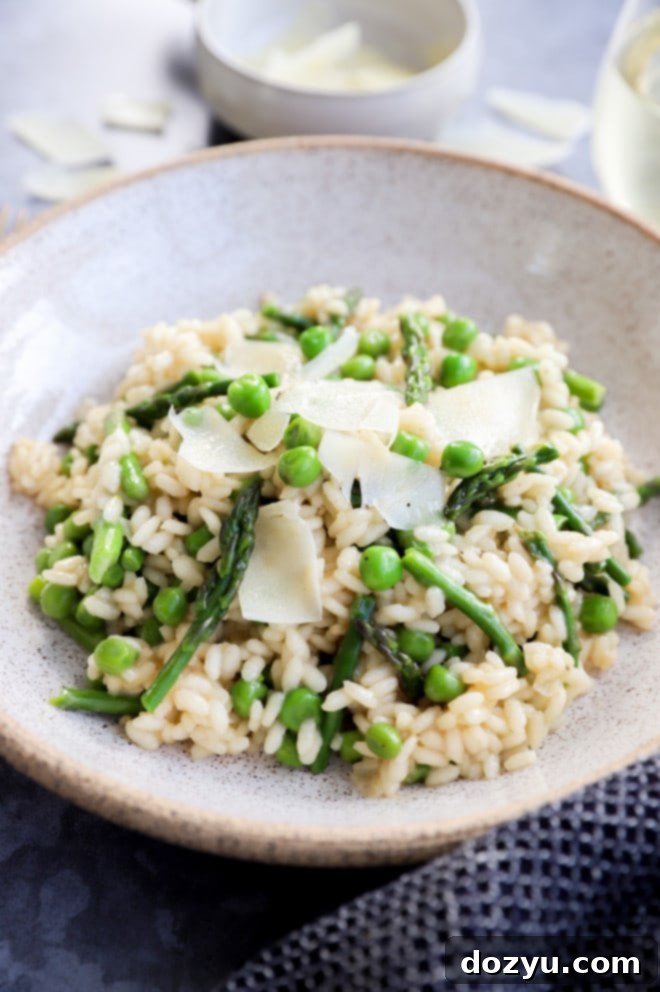
Expert Tips for the Best Risotto
Achieving risotto perfection is easier than you think with a few key techniques:
- Add a Touch of Citrus: For an extra layer of brightness and to cut through the richness, a squeeze of fresh lemon juice stirred in at the very end of cooking can make a world of difference. It adds a vibrant, zesty punch of acid that elevates all the other flavors.
- Taste, Taste, Taste: This is perhaps the most crucial tip in all cooking, especially for risotto. Don’t be shy! Season your vegetables as they cook, and continually taste the risotto as you add stock and at the very end. Adjust salt and freshly ground black pepper to achieve your preferred flavor balance. Remember, you can always add more seasoning, but you can’t take it away.
- Don’t Wander from the Stove: Risotto is a labor of love that rewards your presence. The constant, gentle stirring is vital for releasing the starches from the Arborio rice, which is what creates that luscious, creamy texture. Resist the urge to walk away – staying close ensures you can stir frequently and monitor the absorption of the stock, leading to a perfectly cooked risotto every time.
- Use Freshly Grated Parmesan: As mentioned in the ingredients, opting for a block of Parmesan and grating it fresh will give you a superior flavor and melting quality compared to pre-grated varieties.
Explore More Delicious Risotto Recipes: Don’t limit your risotto adventures to spring! Discover our Winter Roasted Vegetable Risotto, the rich and savory Bacon Butternut Squash Risotto, or the bright and fresh Summer Corn Risotto for year-round comfort.
Why Warm Stock is Crucial for Risotto
You might wonder if keeping the stock warm is truly necessary. The answer is a resounding yes! This seemingly minor step is one of the most important for achieving a truly exceptional risotto. Adding cold stock to hot rice would dramatically drop the temperature of the pan, interrupting the cooking process and shocking the rice grains. This interruption can lead to a longer cooking time and a less creamy, often gummy, final product. By using warm stock, you maintain a consistent cooking temperature, allowing the starches to release smoothly and continuously, resulting in that coveted velvety, creamy texture. So, don’t skip warming your stock – it’s a small effort with a huge payoff!
Choosing the Right Rice for Risotto
When it comes to risotto, not all rice is created equal. This recipe, like most authentic risotto preparations, specifically calls for Arborio rice. Arborio is a short-grain Italian rice known for its high starch content and ability to absorb liquid while maintaining a firm, al dente core. It’s this unique characteristic that gives risotto its characteristic creamy texture without becoming mushy.
While you might technically be able to use long-grain rice for a risotto-like dish, it’s generally not recommended for this specific recipe. Long-grain rice varieties have a different starch composition and require different liquid ratios and cooking methods to achieve a similar consistency. It’s much harder to get the desired creaminess and ‘bite’ with long-grain rice, so for the best results, always stick with Arborio.
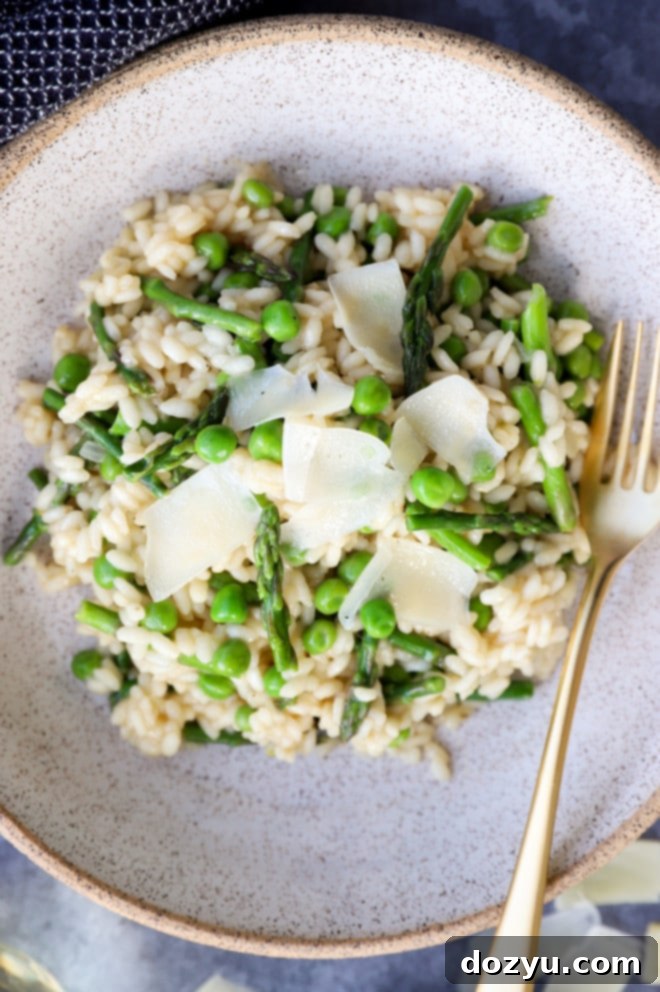
Making Your Asparagus and Pea Risotto Vegetarian
Transforming this delicious spring risotto into a completely vegetarian meal is incredibly simple. The only modification needed is to swap out the chicken stock for a high-quality vegetable stock. With this easy change, your risotto becomes a wonderful vegetarian main course, perhaps served alongside some crispy pan-fried tofu or a vibrant mixed green salad. All other ingredients are naturally vegetarian-friendly, ensuring you don’t miss out on any of the creamy, flavorful goodness.
Can I Make Risotto Without White Wine?
The addition of white wine in risotto serves a dual purpose: it deglazes the pan, capturing all those delicious browned bits, and it adds a layer of bright acidity and complex flavor to the dish. Rest assured, the alcohol content in the wine cooks off almost entirely during the simmering process, leaving behind only its wonderful taste. However, if you prefer to omit alcohol for any reason, you absolutely can! Simply replace the white wine with an equal amount of additional chicken or vegetable stock. While the flavor profile will be slightly different, it will still yield a delicious and creamy risotto.
Storing & Reheating Risotto: A Guide
Generally, risotto is best enjoyed immediately after it’s prepared, when it’s at its creamiest and most luxurious. The starches in the rice continue to absorb liquid as it cools, so leftover risotto won’t have the exact same texture as freshly made. However, if you do find yourself with leftovers, don’t despair! You can still enjoy them with a little care.
Storage: Allow any leftover risotto to cool completely before transferring it to an airtight container. Store it in the refrigerator for up to 2 days. Beyond that, the texture and quality tend to decline significantly.
Reheating: Reheating risotto requires adding a little moisture to bring back its creamy consistency. To reheat, place the desired portion in a microwave-safe bowl. Add about 1 tablespoon of unsalted butter and a splash of white wine or chicken/vegetable stock per serving. Microwave on medium power for 2-3 minutes, then stir thoroughly and check the temperature. Continue microwaving in 30-second increments, adding more liquid (stock or water) as needed, until the risotto is heated through and has regained a desirable creamy, saucy texture, rather than being dry or clumpy.
Freezing: I strongly advise against freezing risotto. The delicate texture of the Arborio rice and its creamy sauce does not hold up well to freezing and thawing. It often results in a grainy, unappetizing consistency that simply doesn’t do justice to the dish.
Craving more seasonal delights? Be sure to browse our dedicated spring recipes page for a wealth of fresh inspiration!
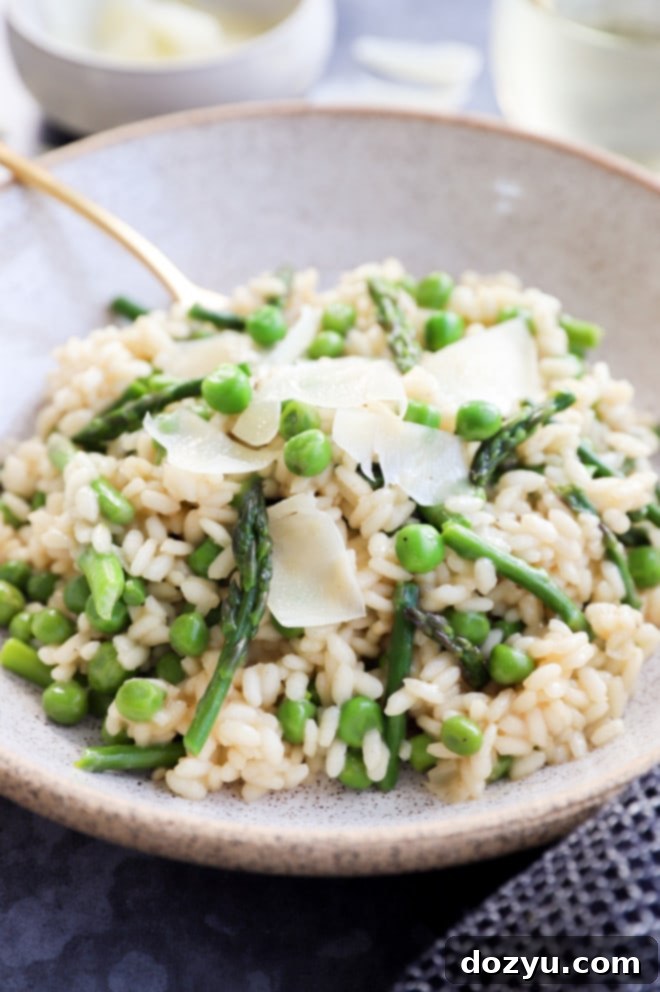
What to Serve with Spring Asparagus and Pea Risotto
This vibrant asparagus and pea risotto is incredibly versatile and pairs wonderfully with a variety of dishes. It’s hearty enough to stand on its own as a fulfilling vegetarian main (especially when made with vegetable stock), yet light enough to complement your favorite proteins.
Given its fresh, spring-forward flavors, I highly recommend pairing it with lighter proteins such as seafood or poultry. However, its rich creaminess also makes it a surprisingly excellent accompaniment to red meats. Here are some delectable pairing ideas:
- Roasted Chicken with White Wine and Fresh Herbs: A classic pairing that offers elegant simplicity. The chicken can roast in the oven while you prepare your risotto, making for a perfectly timed and stress-free meal.
- Sous Vide Chicken Thighs: For incredibly tender and flavorful chicken, try this sous vide chicken thigh recipe. Slice the juicy thighs and serve them directly over a generous bed of creamy risotto.
- Air Fryer Scallops with Chive Lemon Butter: If you’re looking for a quick yet impressive option, these air fryer scallops cook in minutes and are a match made in heaven with the spring risotto, offering a delicate sweetness and a bright, zesty counterpoint.
- Air Fryer Bacon Wrapped Pork Loin: For something a bit more robust, the savory crispiness of this bacon-wrapped pork loin provides a fantastic contrast to the creamy risotto.
- Herb Crusted Rack of Lamb: Planning a special spring dinner party? Elevate the occasion by serving this risotto alongside a succulent herb-crusted rack of lamb. The flavors intertwine beautifully for an unforgettable culinary experience.
For an extra layer of indulgence, consider topping your risotto with crispy pieces of crumbled bacon or thinly sliced prosciutto, in addition to the shaved Parmesan. It adds a delightful textural contrast and a boost of savory flavor!
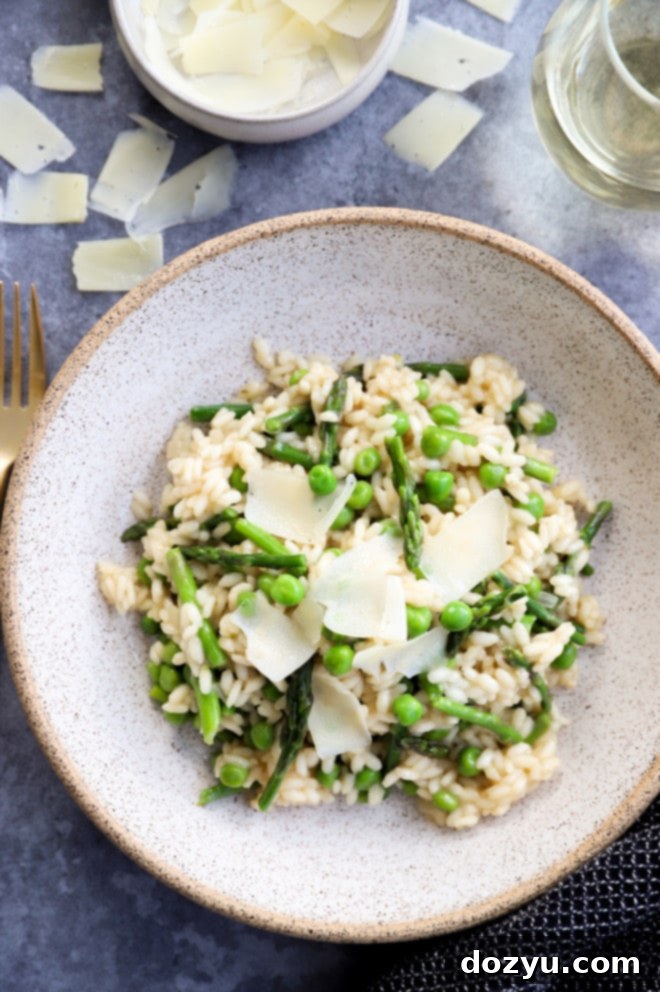
Finally, if you fall in love with this creamy Asparagus and Pea Risotto recipe, please consider leaving a rating or a comment below! Your feedback means the world to me, and I always take the time to respond to every single comment. Feel free to ask any questions you might have about the recipe too!
And if you share your culinary creations on Instagram, don’t forget to tag me! Seeing these recipes come to life in your homes is truly my favorite thing, and I love admiring all your beautiful photos. It genuinely brightens my day!
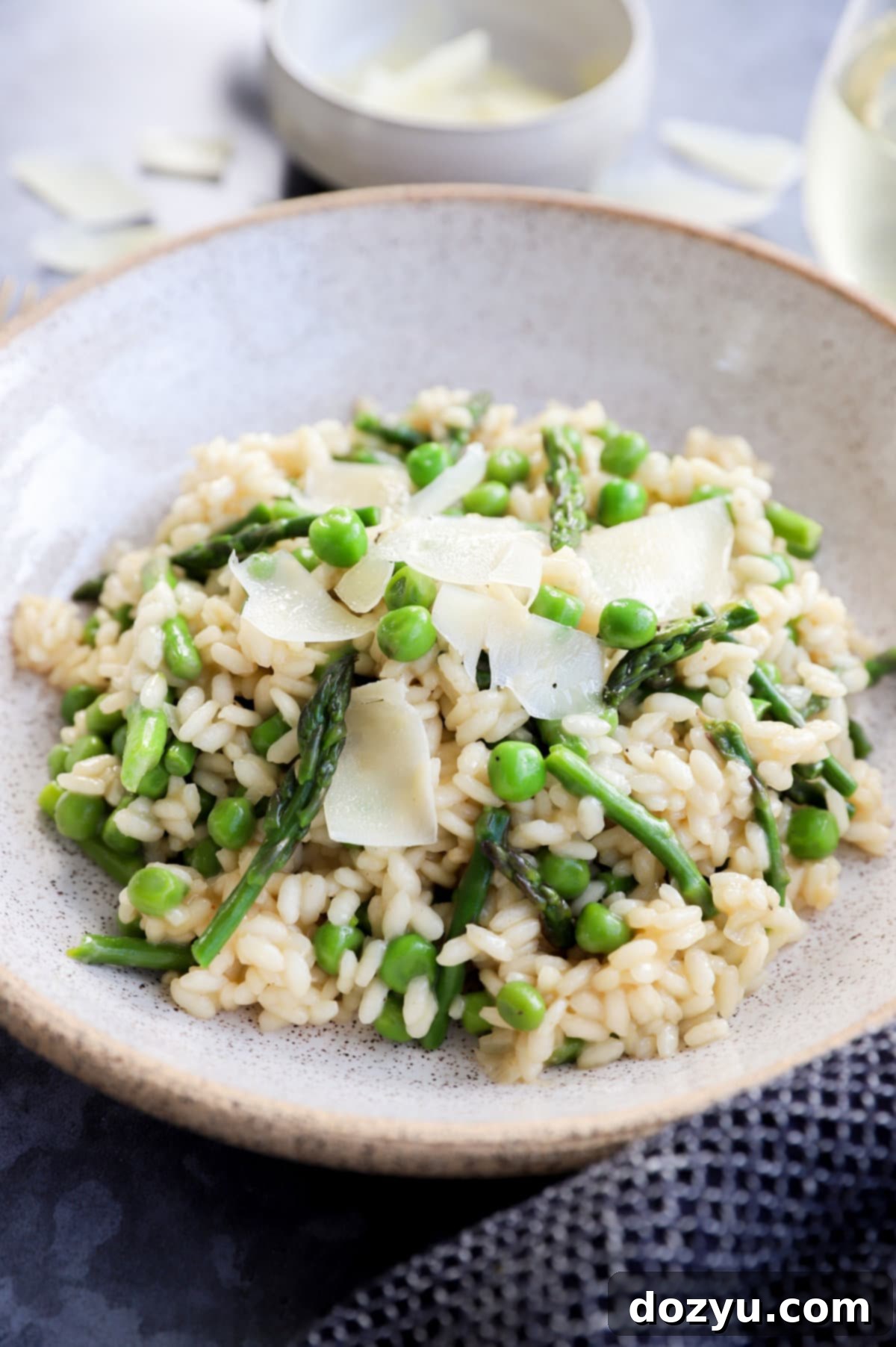
The Full Recipe: Spring Asparagus and Pea Risotto
Equipment
-
Le Creuset Saucepan
-
Wooden Spoon & Scraper
-
Nonstick 12-Inch Skillet
Ingredients List
- 2 to 3 cups chicken or vegetable stock
- 1 Tbsp olive oil
- 1 bunch asparagus preferably thin, trimmed and cut into 1-in pieces
- 1 cup frozen peas
- 3 Tbsp unsalted butter separated
- 2 shallots finely chopped
- 2 garlic cloves minced
- 1 1/2 cups arborio rice
- 1 cup dry white wine like Chardonnay, Sauvignon Blanc, or Pinot Grigio
- 1/4 cup freshly grated parmesan cheese
Detailed Instructions
-
Warm the Stock: In a small saucepan, bring the chicken or vegetable stock to a gentle simmer. Cover and keep it warm over low heat throughout the cooking process.
-
Cook Vegetables: In a large skillet (like a risotto skillet), heat the olive oil over medium-low heat. Add the trimmed 1-inch asparagus pieces and season with salt and pepper. Cook, stirring occasionally, until the asparagus is crisp-tender, approximately 2 to 4 minutes (depending on thickness). Stir in the frozen peas and cook for about 1 minute until defrosted. Transfer the cooked vegetables to a plate or bowl and set aside.
-
Sauté Aromatics & Toast Rice: In the same skillet, melt 2 tablespoons of unsalted butter over medium heat. Add the finely chopped shallots and cook until softened, about 2 to 3 minutes. Stir in the minced garlic and cook for 1 minute until fragrant. Add the Arborio rice and toast, stirring occasionally, for about 2 minutes.
-
Build the Risotto: Pour in the white wine and simmer, stirring constantly, until it has almost completely evaporated. Now, add approximately 1 cup of the warm stock. Cook, stirring continuously, until the stock has been fully absorbed by the rice. Repeat this process, adding 1 cup of stock at a time and stirring until the rice is tender, creamy, and has an al dente bite. This will take approximately 25 to 35 minutes in total. You may not need all of the stock, so taste the rice between each addition.
-
Finish & Serve: Stir in the reserved cooked asparagus and peas, the freshly grated Parmesan cheese, and the remaining 1 tablespoon of butter until melted and combined. Season the risotto with salt and pepper to taste. Keep warm over low heat until ready to serve. Garnish each serving with shaved Parmesan cheese.
Recipe Video
Nutrition Information
Carbohydrates: 74g |
Protein: 13g |
Fat: 16g |
Saturated Fat: 7g |
Polyunsaturated Fat: 1g |
Monounsaturated Fat: 6g |
Trans Fat: 0.3g |
Cholesterol: 32mg |
Sodium: 292mg |
Potassium: 437mg |
Fiber: 5g |
Sugar: 6g |
Vitamin A: 900IU |
Vitamin C: 19mg |
Calcium: 93mg |
Iron: 5mg
